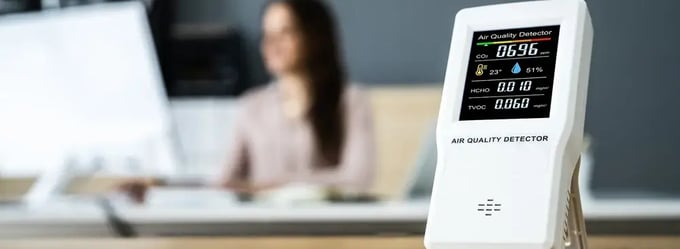There is no doubt that the modern workspace is evolving. The global pandemic has brought new workplace attitudes. The office is now seen as the hub for collaborative work. It is also responsible for employee well-being and productivity.
IoT devices have been essential in transforming office spaces into smart workspaces. These spaces can automatically manage shared areas, sustain a healthy environment, and save on utility costs. Optimizing these spaces is integral as for most companies, real estate constitutes the second-largest cost. We have therefore identified three noteworthy categories of IoT devices for the smart office, exploring their benefits and critical features.
The major trends pushing smart office technology
Dynamic workspaces
Work behaviors like hot-desking and coordinating shared meeting rooms were already present before the pandemic. Now, these systems, as well as social distancing, are essential and regulated. A report by Microsoft found that 66% of employers around the world are adapting their workplaces for hybrid work arrangements. This is changing the purpose of the office to be used for more collaborative work.
Extra workplace strategies have been implemented to prevent the spread of COVID-19. These strategies include social distancing, limiting occupancy in shared areas, and cleaning protocols. These changes could have a major effect on how employees use their space. It could even require permanent changes to the space to fit the new working environment.
Workspaces that support employee wellbeing
Employers are recognizing the importance of the office environment on employee well-being. This has a major impact on productivity. Hybrid working is one way to achieve this. Therefore, ensuring buildings have optimum environmental conditions such as temperature and lighting is essential.
Air quality is critical. A Harvard study reported that poor indoor air quality can significantly reduce workspace productivity by over 50%. In order to provide a healthy work environment, more responsive HVAC and lighting systems are needed.
Reducing maintenance costs
Water leaks are a major issue and cost insurance providers more than US$2.5B a year in the US alone. This is especially evident in commercial buildings, such as offices. The higher density of plumbing appliances, like toilets, kitchens, and HVAC systems, means they are used more often.
On top of the higher likelihood of leaks, vacant properties from the global pandemic add to the potential damage. During the pandemic, many office buildings were not in use for long periods of time which left pipe networks damp providing the optimum conditions for corrosion.
Furthermore, more refurbishments and downscaling into new premises can cause more potential leaks from the remodeled plumbing. This underlines the necessity of predictive maintenance tools so appropriate action can be taken early.

Three main types of smart office technology
1. Occupancy sensing
Occupancy detection has many important applications in the post-pandemic work environment. It also has the potential to reduce operating costs significantly.
Firstly a major organizational challenge in the post-pandemic office is how we share spaces safely without compromising workflow. Fortunately, occupancy sensing devices can detect if a room is occupied or not. This means spaces can be managed remotely. This includes accounting for the maximum capacity regulations and time for ventilating rooms in between sessions.
Smart AI cameras or radar devices use visual or spatial information respectively to identify exactly how many people are present. This can also be done with people counters installed more discreetly at doorways to count the flow of people into and out of a room.
In the case of hot-desking and social distancing, individually installed passive infrared (PIR) sensors can automatically create a map of where seats are unoccupied. This can guide cleaning routines based on need. It can also control lighting and HVAC systems to conserve energy in unoccupied rooms.
Building managers can save real estate costs by temporarily or permanently closing areas they know are not being used. This knowledge can be obtained through extra analysis.
Automatic insights can provide a range of occupancy detection uses. This relieves facility managers from the pressure of manually carrying out these observations or employing expensive consultants.

2. Indoor air quality (IAQ) monitoring
Poor office air quality can arise from many causes and can contribute to significant short andvlong-term health risks for employees. Air quality is especially important as many studies have linked poor IAQ with the increased likelihood of transmitting viruses.
Variables like temperature, humidity, carbon dioxide, carbon monoxide, and particulate matter levels are essential for measuring the probability. These must be monitored closely. Modern air quality sensors can detect more than 15 types of environmental conditions and pollutants. This makes it simpler to adjust HVAC systems as needed.
Even if IAQ is not health-threatening, poor environmental conditions can undetectably decrease employee well-being and therefore productivity. Sensors can detect factors such as lighting, humidity, and air pressure. This helps to ensure that employees are as comfortable as possible. Corrections can be made to optimize this comfort.
Many environmental monitoring systems can be connected to cloud analytics. This transforms raw data into useful actions. This removes the burden from facility managers, who no longer need to interpret live information.

3. Water leak detection
We have established that predictive maintenance is essential for the modern workplace. This is to prevent the risk of water leaks. Office buildings, especially high-rises, have weak points that are prone to leaking. Examples include flat roofs, windows, and HVAC systems.
Luckily there is a selection of water leak sensors that take a proactive approach to early water leak detection. Flow meters can be installed in plumbing networks. They can detect changes in flow, velocity, or pressure. This can be used to indicate if there is a leak.
A more localized approach uses flood sensors or sensor cables that are triggered when in contact with water. These methods can detect the very first drops of a leak as well as locate the source. Sensor cables are a more flexible and scalable option, so are ideal for large spans of areas such as roofs.
Aside from being able to prevent water damage, monitoring water usage and leaks can mitigate considerable water waste. The EPA reports that an average household wastes nearly 10,000 gallons of water through leaks per year. This scaled to a commercial building emphasizes the importance of water leak detection.

Key features to consider in smart office technology
The global smart building market is expected to increase significantly. It currently covers IoT sensing devices, and is projected to rise from US$67B in 2021 to US$265B by 2028. This projection demonstrates the need for more efficient and intelligent systems. However, certain factors must be taken into consideration.
Delivering accurate and live data
Primarily, facility managers value systems that are accurate and are less likely to cause false alarms. It is important to receive alerts and live data promptly. For example, in the situation of a burst pipe, minutes wasted can lead to gallons of water lost.
Protecting privacy and security
What is coming into concern, especially from an employees’ perspective is how these devices could breach privacy. Cameras used for occupancy sensing are very precise in detecting people and their environment. This can, however, make people feel uncomfortable, even if the data is not stored and complies with GDPR regulations. Therefore selecting a sensing mechanism such as PIR that only detects movement for example can be more suitable.
More internet-connected devices also emphasize the need for security-protected devices. Therefore IoT systems must be developed robustly, sending only encrypted messages to prevent the likelihood of cyberattacks.
Scalable technology
Scalability is a fundamental aspect we see from multiple angles: installation, cost and power efficiency. A water leak sensor may be accurate, but it is useless if it only covers a small area under a pipe. Other critical areas may need monitoring as well.
Cost-effectiveness is essential. Installation and maintenance costs must be taken into account, as they affect the return on investment from these devices.
Action-based insights
Finally, smart buildings should have a unified platform for facility managers to understand. This platform should integrate multiple types of IoT sensing devices and methods of communication. This is essential as in-depth data is futile if actions cannot be taken efficiently.

LAIIER’s solution and vision
At LAIIER, we have identified and designed all three sensing categories that are essential to smart office transformation. Our sensors are unique printed and flexible materials to adapt to any surface whether in cramped or extensive spaces. This form factor combined with our sensing techniques makes installation and operating costs very economical and scalable.
Smart building technology is a system, not a standalone product. This has been highlighted by many Internet of Things (IoT) devices for occupancy detection, air monitoring, and water leak sensing. Therefore, we have also developed our LAIIER Cloud™ which allows for wireless and power-efficient communication via LoRaWAN®. Alerts and insights can thus be proactively communicated to key stakeholders such as facility managers.
The office workspace is changing significantly due to the current uncertainty. We are certain, however, that these changes will create a more employee-focused dynamic space.
Hybrid working is the new normal. To adapt to it, IoT devices are essential. They can help to organize and monitor a healthy and cost-effective workplace.